The Economics and Statistics Division maintains archives of previous publications for accountability purposes, but makes no updates to keep these documents current with the latest data revisions from Statistics Canada. As a result, information in older documents may not be accurate. Please exercise caution when referring to older documents. For the latest information and historical data, please contact the individual listed to the right.
<--- Return to Archive
For additional information relating to this article, please contact:
May 28, 2021SURVEY ON BUSINESS CONDITIONS, IMPACT OF COVID-19: Q2 2021 Because of the rapid changes in business conditions during the COVID-19 pandemic, Statistics Canada has conducted a fifth iteration of the Canadian Survey on Business Conditions. In early April, Statistics Canada surveyed businesses to collect information on the pandemic's impact and on businesses' expectations moving forward. Additional details are available for businesses by majority ownership and international activities.
The results reported here are a selection of the impacts found for Nova Scotia businesses, by industry, by size of business (measured by number of employees), by age of business and by urban or rural location. There are comparisons of the Nova Scotia average (all industries, ages, sizes, locations) with the national and provincial averages. The horizontal axis in all charts measures the share of businesses reporting each outcome. The total for many outcomes does not add to 100% of respondent businesses as many replied that the outcome was not applicable in their circumstances.
Business expectations
Looking forward over the next 12 months, 77.4% of Nova Scotia business respondents felt very or somewhat optimistic about business conditions while 9.7% were not optimistic. Business optimism was stronger in Nova Scotia's low contact service industries. Nova Scotia businesses in construction, mining, arts/recreation, accommodation/food and personal/repair services. Across Canada, optimism was stronger in Quebec and Atlantic Canada.
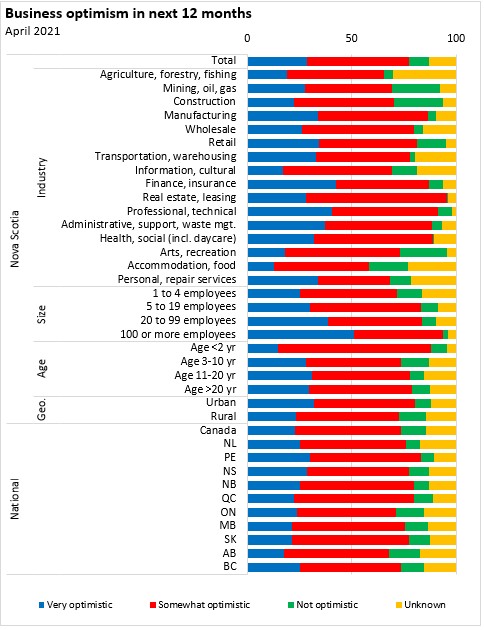
Looking over the next three months 73.0% of Nova Scotia businesses expect stable or rising sales while 18.7% expect a decline. Rising sales were noted particularly for manufacturing, wholesale, retail, real estate/leasing and administrative/support (including waste management). Across Canada, businesses in the Maritimes, Quebec and British Columbia were more likely to report expectations for rising sales.
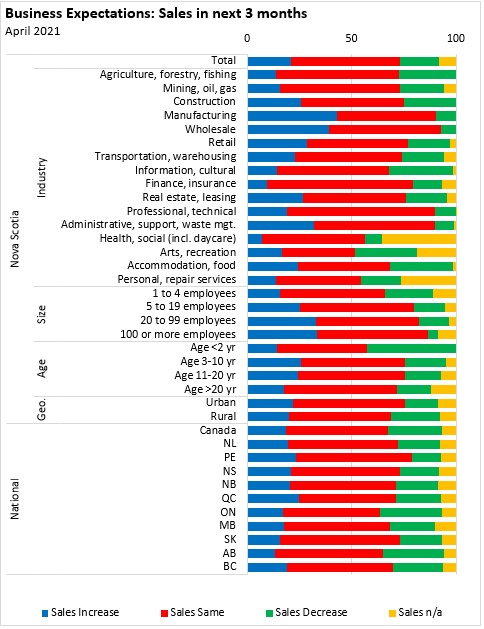
Business profitability is expected to remain the same for just over 50% of Nova Scotia businesses in the next three months while 16.3% expect rising profitability and 26.8% expect decreasing profitability. Rising profitability is expected more in Nova Scotia's manufacturing, wholesale, retail, transportation, professional/technical and administrative/support businesses. Decreasing profitability is expected more in arts/recreation and accommodation/food businesses.
Across Canada the outlook for profitability is stronger in Atlantic Canada and notably lower in Ontario.
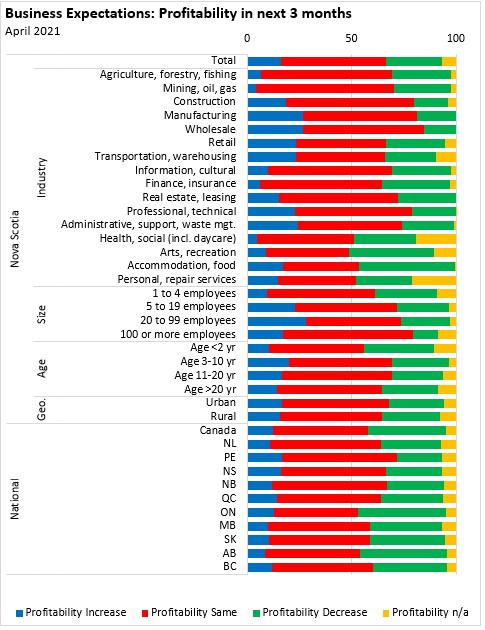
The outlook for employment is stable for 75.1% of Nova Scotia businesses in the next three months. Rising employment is expected among 15.3% of Nova Scotia businesses while declining employment is expected by 7.6% of Nova Scotia businesses. Rising employment is notably more prevalent among medium and larger businesses than it is among small businesses. Across Canada, employment expectations are stronger in Atlantic Canada and Quebec.
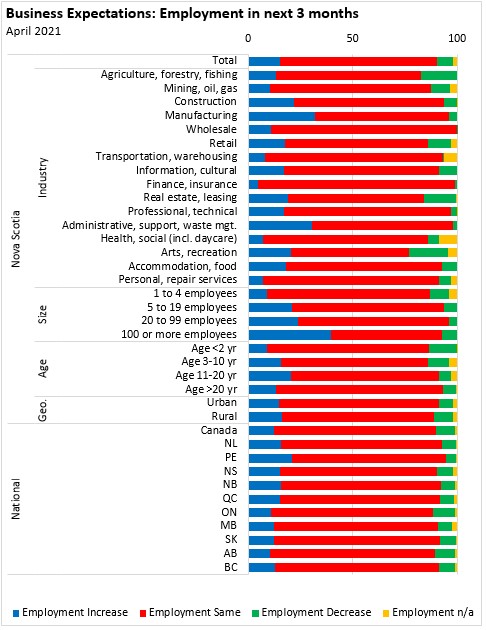
Obstacles for businesses
As part of the Survey of Business Conditions, businesses were asked about their obstacles.
- 22.9% of Nova Scotia businesses report shortages of skilled labour. This was more acute in construction, manufacturing, accommodation/food and larger businesses. Across Canada, Quebec businesses report greater obstacles from labour shortage.
- 31.8% of Nova Scotia businesses report obstacles from recruiting skilled labour. The obstacle was more sizable for construction, retail, wholesale and health care/social (including daycare) as well as among larger Nova Scotia businesses. Across Canada, recruitment of skilled labour was an obstacle for more businesses in Quebec, Prince Edward Island and Nova Scotia.
- 20.9% of Nova Scotia businesses report obstacles from retaining skilled labour, more so among larger businesses as well as in construction and retail industries.
- Rising input costs were cited as an obstacle for 35.6% of Nova Scotia businesses. This was particularly prevalent among goods-producing industries as well as in accommodation/food and in newer businesses. Across Canada, Saskatchewan reports notably higher obstacles from rising input costs.
- 15.6% of Nova Scotia businesses report obstacles from insufficient demand, but this is a much larger obstacle for arts/recreation and accommodation/food businesses as well as for newer businesses.
- Transportation costs were an obstacle for 20.1% of businesses in Nova Scotia. This was more common among goods-producing businesses as well as in wholesale, retail administrative/support and accommodation/food businesses.
- Financing was an obstacle for only 7.6% of businesses, but this was higher for newer businesses.
- 19.5% of businesses in Nova Scotia report that government regulations were an obstacle. This was higher among businesses in agriculture/forestry/fishing as well as accommodation/food. A higher portion of newer businesses cited government regulation as an obstacle. Across Canada, government regulations were more of an obstacle for businesses in Ontario and the Prairie provinces.
- Travel restrictions were an obstacle for 29.1% of Nova Scotia businesses, with a greater share in mining, information/culture, wholesale and accommodation/food businesses. Newer businesses were more likely to cite travel restrictions as an obstacle. Across Canada, travel restrictions were an obstacle for fewer businesses in Quebec.
- Rising competition was an obstacle for 12.2% of Nova Scotia businesses, and this was particularly concentrated among newer businesses.
- 19.1% of Nova Scotia businesses reported cash flow and debt management as an obstacle, particularly in accommodation/food, personal/repair, retail and arts/recreation businesses. Newer businesses also face obstacles from cash flow/debt management.
- 8.9% of Nova Scotia businesses face obstacles from internet connections, more so in rural businesses.
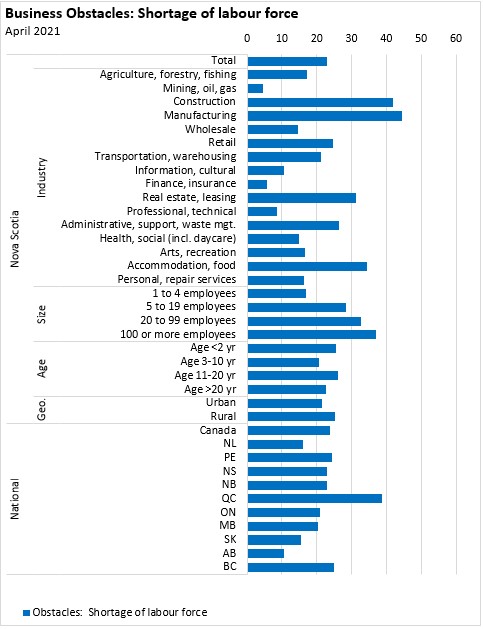

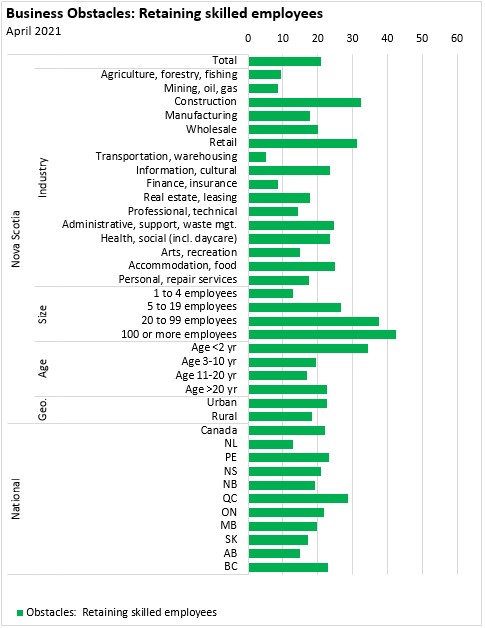
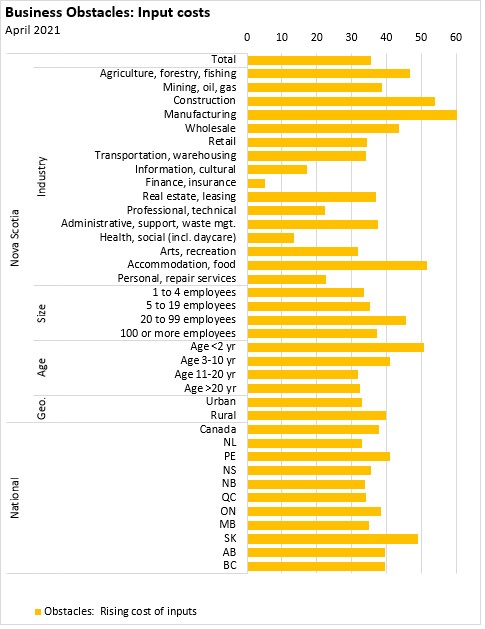


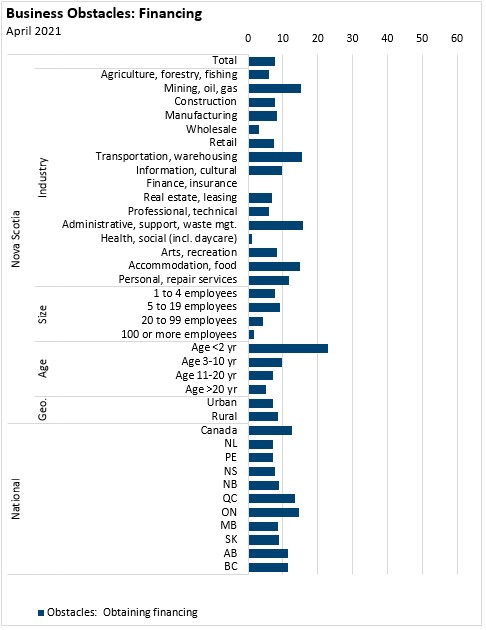
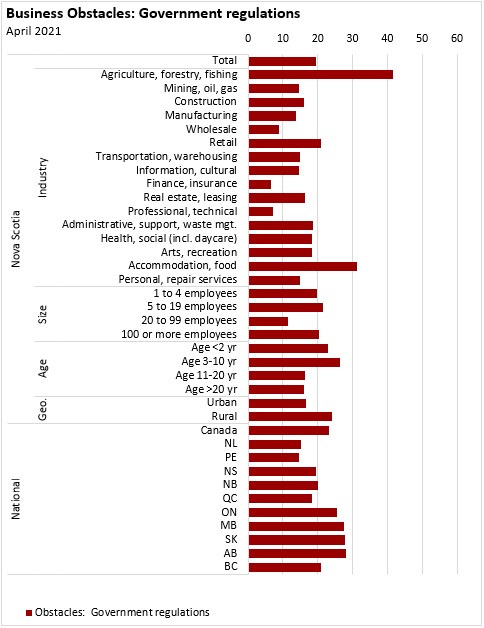
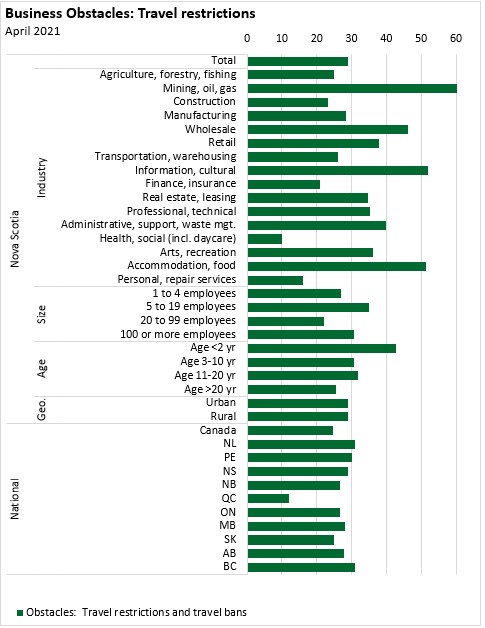

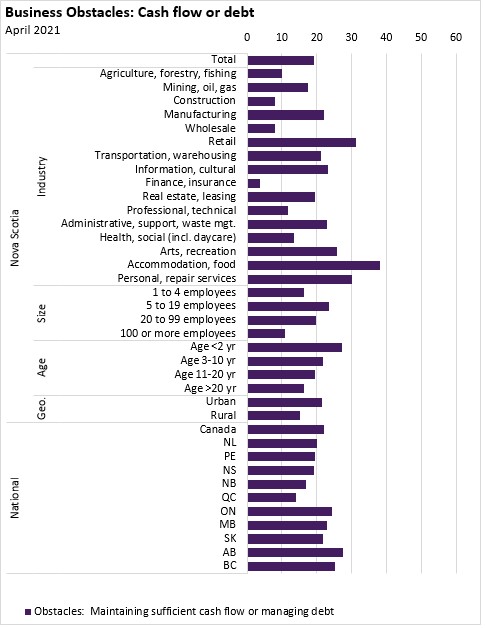

Temporary closures and re-openings, plans for sale/closure
Over 81% of Nova Scotia businesses have no plans to sell, transfer or close their business in the next 12 months while 2.6% plan to sell/transfer and 0.2% plan to close (15.9% have unknown plans about sale/transfer/closure). Sale/transfer and closure plans were more commong among businesses in mining, accommodation/food, arts/recreation, professional/technical, manufacturing, agriculture/forestry/fishing and administrative support industries.
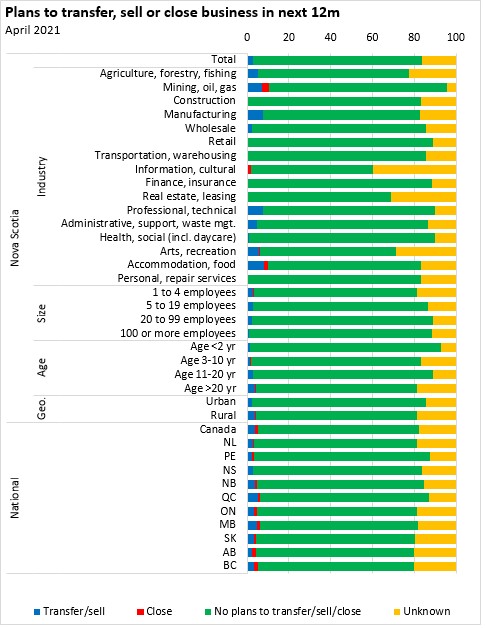
Sources of additional funding or credit
During the pandemic, businesses have sought additional funding from government supports as well as private financing. Among Nova Scotia businesses:
- 48.6% used the Canada Emergency Business Account
- 20.9% used the temporary 10% wage subsidy
- 39.8% used the Canada Emergency Wage Subsidy
- 9.1% used the Canada Emergency Rent Subsidy
- 2.7% used the Canada Emergency Commercial Rent Assistance
- 7.8% used Provincial/Municipal support programs (concentrated in health/social/daycare, arts/recreation, accommodation/food)
- 3.7% received additional funds from a financial institution
- 27.8% received no additional funding
- Of those that received no additional funding, 61.4% did not need additional funding while 26.2% were ineligible for additional funding and 5.6% found the application too complicated
- 80.6% of businesses in Nova Scotia report having sufficient cash or liquid assets to support operations while 4.7% have insufficient cash or liquid assets (14.7% answered unknown)
- Only 6.3% of Nova Scotia businesses reported negative effects of the pandemic on their credit rating while 64.4% reported no change (and 29.2% were unknown)
- 25.3% of Nova Scotia businesses report being able to take on more debt while 14.6% report being unable to take on more debt. The capacity to take on more debt was unknown for 19.0% of Nova Scotia busineses while 41.1% report no need to take on more debt.

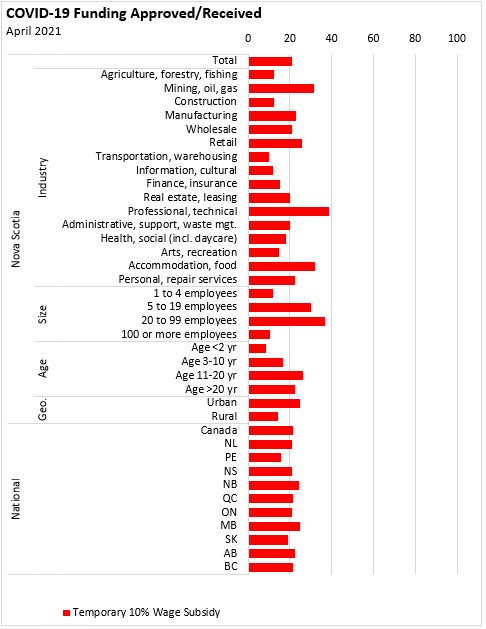
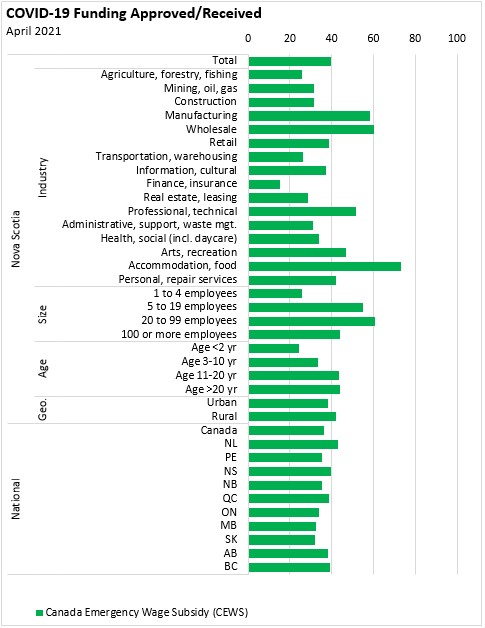
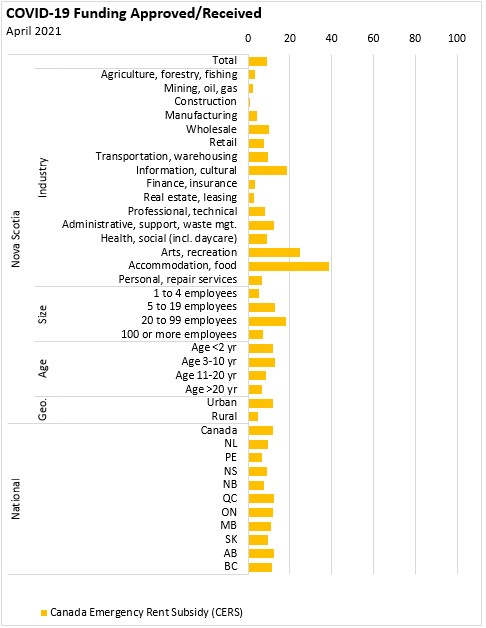
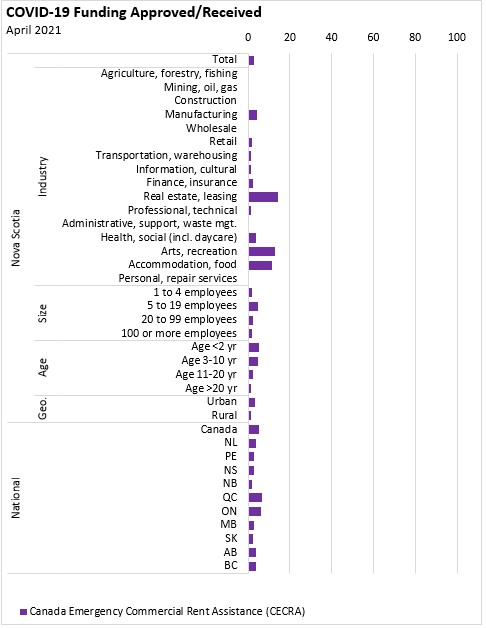
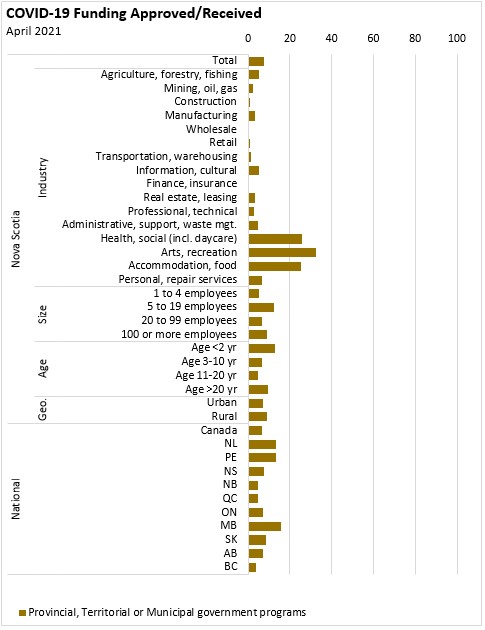
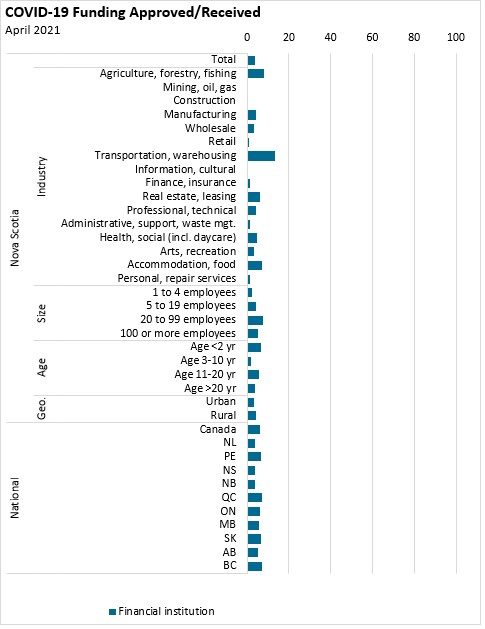
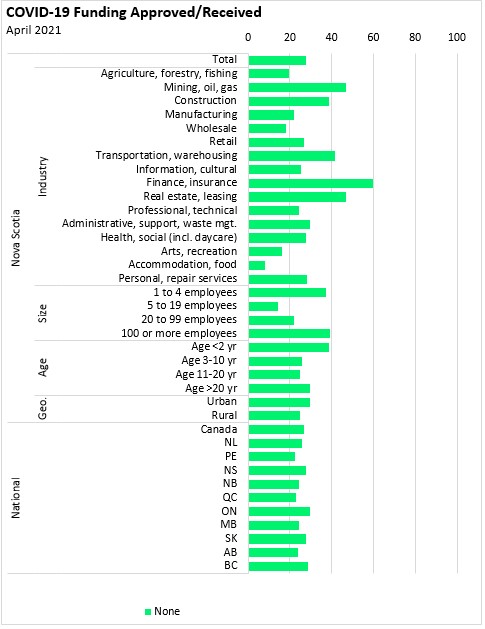

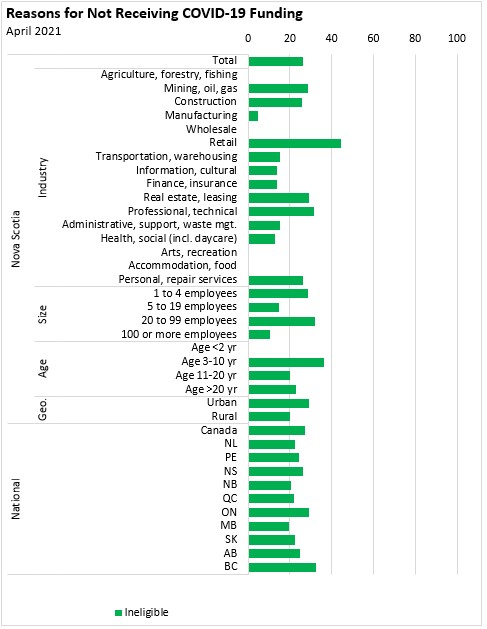
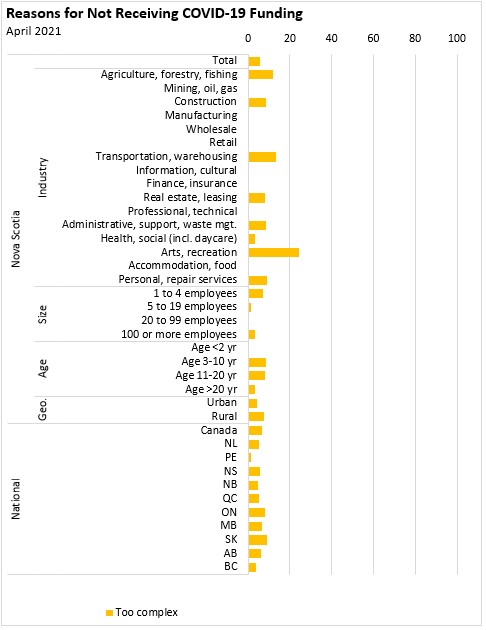
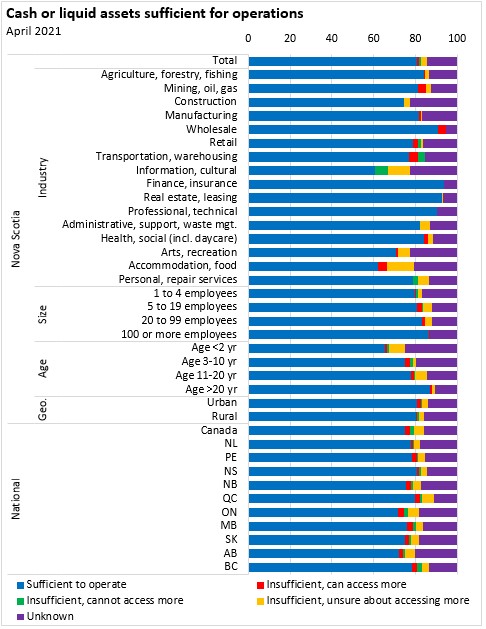
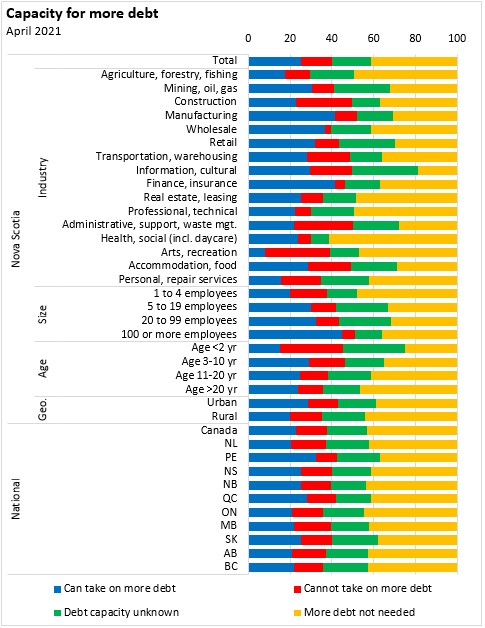
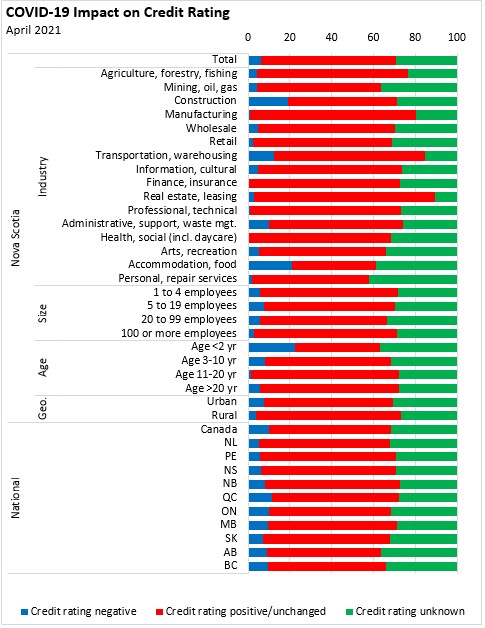
Adopting new practices after COVID-19
Businesses in the Survey on Business Conditions were asked whether they were likely to adopt new practices coming out of the pandemic.
- Only 10.7% of Nova Scotia businesses report that it is somewhat or very likely to offer the possibility of telework or remote work (this was not relevant for 58% of respondents). Requiring telework or remote work was somewhat or very likely for 5.7% of businesses (and not relevant for 59.4%). Requiring on-site work was somewhat or very likely for 20.8% of businesses (and not relevant for 62.5%).
- 5.8% of Nova Scotia businesses thought it somewhat or very likely that they would adopt new shiftwork to increase the distance between employees (not relevant for 61.8%) while 13.5% thought it somewhat or very likely to modify work spaces to increase distances between employees (not relevant for 52.3%).
- 14.5% of businesses indicated that they were very or somewhat likely to increase online sales capacity (not relevant for 63.5% of businesses) while 18.8% of businesses were somewhat or very likely to adopt forms of contactless delivery or pickup (not relevant for 54.7% of businessess).
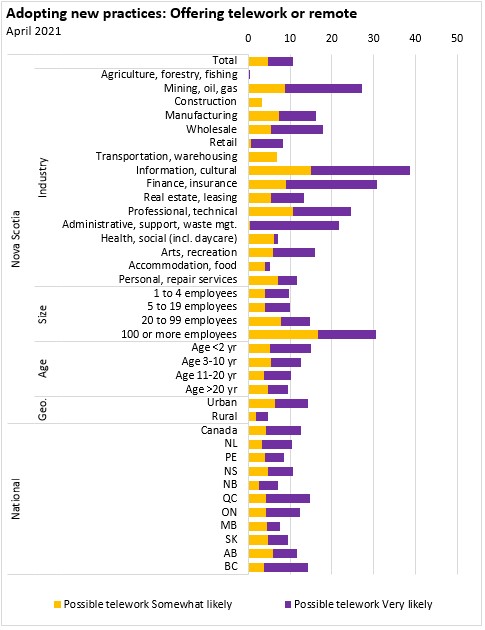
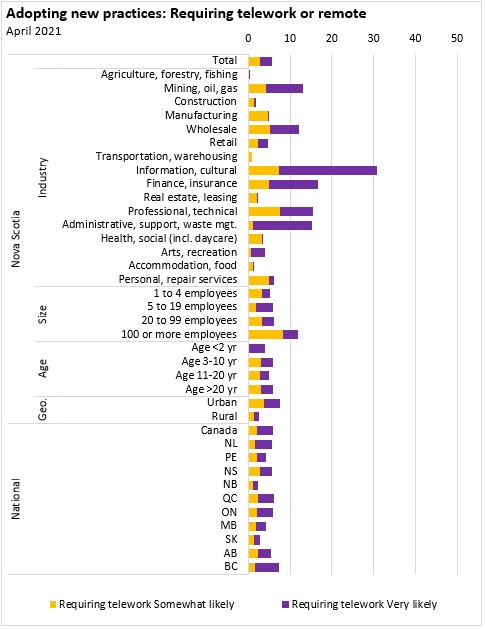

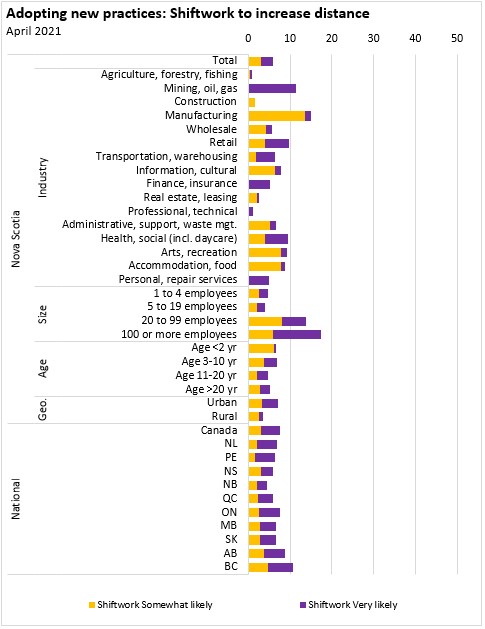
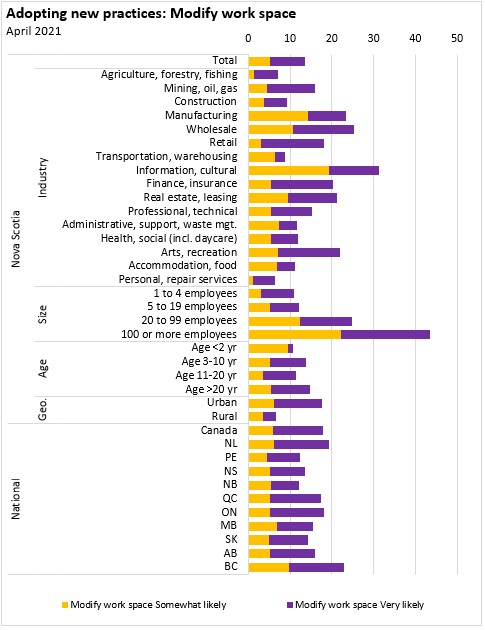
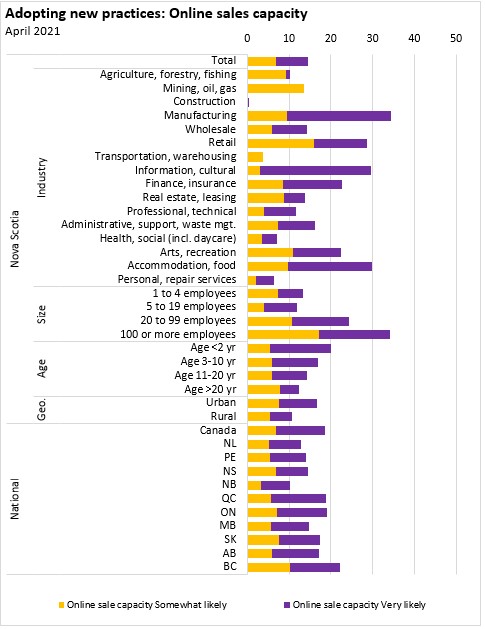
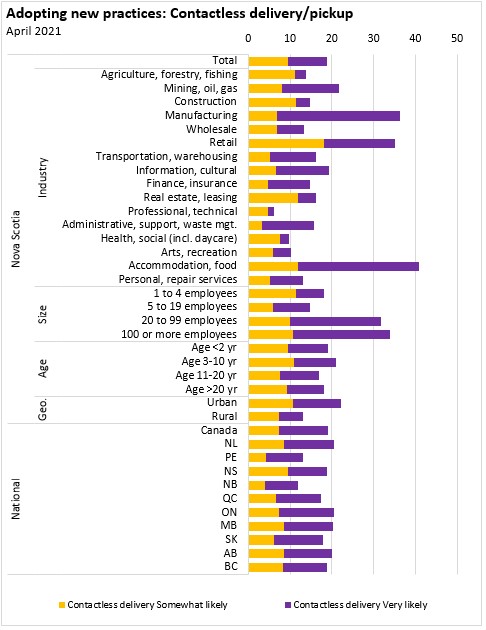
Sources: Statistics Canada. Table 33-10-0337-01 Business or organization expectations over the next three months, by business characteristics, second quarter of 2021
Table 33-10-0338-01 Business or organization obstacles over the next three months, by business characteristics, second quarter of 2021
Table 33-10-0340-01 Plans to transfer, sell, or close business in the next 12 months, by business characteristics, second quarter of 2021
Table 33-10-0350-01 Sources of funding approved or received due to the COVID-19 pandemic, by business characteristics, second quarter of 2021
Table 33-10-0351-01 Reasons business or organization did not access any funding or credit due to the COVID-19 pandemic, by business characteristics, second quarter of 2021
Table 33-10-0352-01 Impact on credit rating due to the pandemic, by business characteristics, second quarter of 2021
Table 33-10-0353-01 Liquidity and access to liquidity over the next three months, by business characteristics, second quarter of 2021
Table 33-10-0354-01 Ability for the business or organization to take on more debt, by business characteristics, second quarter of 2021
Table 33-10-0355-01 Likelihood of various measures being permanently adopted once the COVID-19 pandemic is over, by business characteristics, second quarter of 2021
<--- Return to Archive